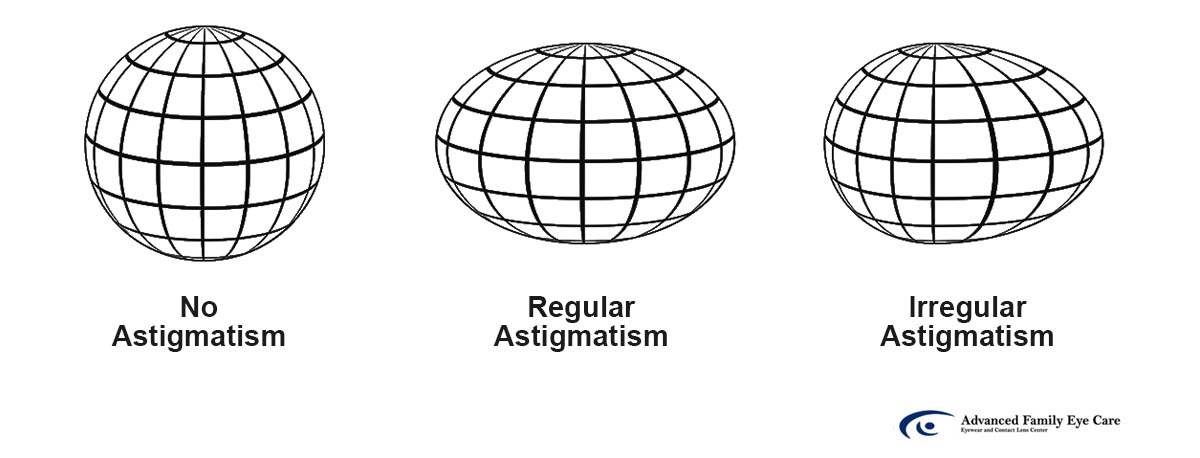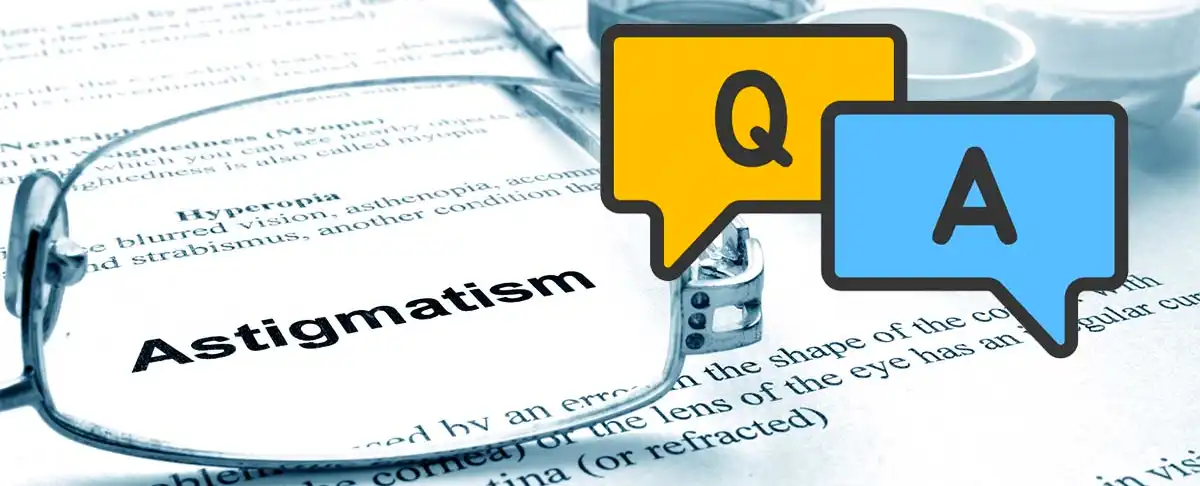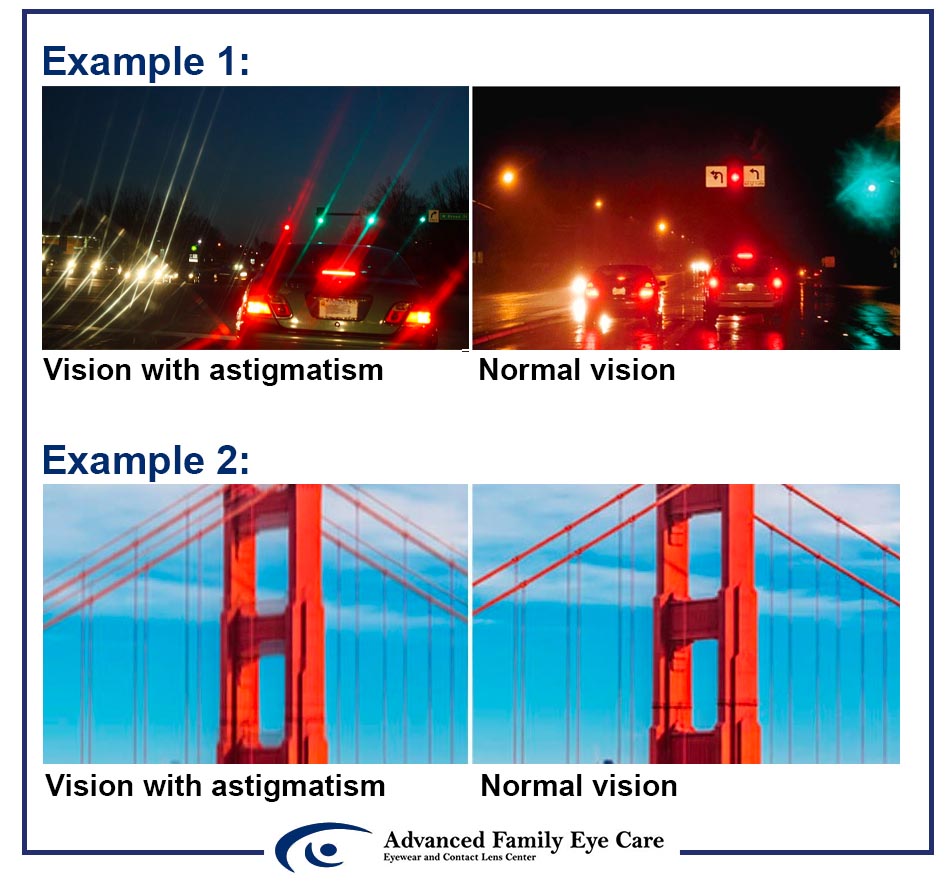Astigmatism Q&A

Reviewed for accuracy by Brad Boyle, OD – Written by Advanced Family Eye Care staff on November 23, 2020 – Last edited on March 30, 2025
 Reviewed for accuracy by Brad Boyle, OD – Written by Advanced Family Eye Care staff on November 23, 2020 – Last edited on March 30, 2025
Reviewed for accuracy by Brad Boyle, OD – Written by Advanced Family Eye Care staff on November 23, 2020 – Last edited on March 30, 2025
Astigmatism is a type of refractive error that results in blurred or fuzzy vision. It is a very common eye condition, affecting approximately 1 in 3 people in their lifetime.
As a leading eye care provider practicing optometry in the Cedar Valley region of Iowa since 1979, we’re here to answer your questions.
Jump to:
What do people with astigmatism see?
What is the main cause of astigmatism?
Does astigmatism worsen with age?
How can astigmatism be corrected?
Can astigmatism go away on its own?
Do you need glasses for astigmatism?
What is the difference between regular and irregular astigmatism?
Can you go blind from astigmatism?
What is astigmatism?
Astigmatism is defined by an abnormality in the shape of either the cornea (the outer surface of the eye) or the lens (a structure inside of the eye). In a normal eye, the curve of the cornea and lens are the same shape. With astigmatism, there is a mismatch between the two, affecting the eye’s ability to properly focus its image.
What do people with astigmatism see?
Individuals with astigmatism have blurred, fuzzy, or distorted vision at near and far distances alike. In terms of what this actually looks like to those who have the condition, here are some examples.
Astigmatism is when the cornea is slightly curved rather than completely round..
— Unusual Facts (@UnusualFacts6) March 25, 2019
With astigmatism, light focuses on several points of the retina rather just one point. This is what people with Astigmatisms vs without. pic.twitter.com/RXWWayFBRJ
The Twitter account Unusual Facts tweeted a visual representation of what people with astigmatism see that has gained quite a bit of attention. The image illustrates a lens flare effect of night time car lights.
While many with astigmatism considered the visual to be accurate, some thought otherwise, including one Twitter user:
Right, except that's not what astigmatism looks like at all. I have it, and its more like seeing this. pic.twitter.com/OHWOq20ziL
— Coffee and Clonazepam (@Fractusrat) March 27, 2019
In this example, the image is seen as blurred or double-vision. Many of our patients with astigmatism describe what they see as double vision but only in one eye.
So the answer to what people with astigmatism see is that it depends. It can vary based on the level of severity of the condition, type of image being viewed, and time of day. Regardless of these factors, those with astigmatism can expect to see some form of blurriness, fuzziness, or distortion.
POLL: Do you have astigmatism? Tell us what you see!
How common is astigmatism?
Astigmatism is among the most common conditions seen in the exam room. It is estimated that 1 in 3 people have some level of astigmatism.
What is the main cause of astigmatism?
People may be born with astigmatism or naturally develop it later on in life. It may also develop as the result of a disease, eye injury, or surgery. Astigmatism is not caused by everyday factors such as too much screen time or reading in low light, contrary to some belief.
While astigmatism may develop due to rare external factors, the main cause of astigmatism is your genetics. Most cases of astigmatism include a hereditary basis.
Does astigmatism worsen with age?
Astigmatism tends to worsen with age as the result of a loss of muscle tone in the eyelids. Eyelids play a role in maintaining the shape of your cornea by maintaining pressure. As muscle tone worsens, the cornea has less support and may further develop abnormalities.
How can astigmatism be corrected?
Astigmatism can be easily corrected with eyeglasses, contact lenses, or laser eye surgery (LASIK).
Eyeglasses
Eyeglasses are curved to compensate for the abnormality in the shape of the eye that is causing the blurred vision. They allow light to bend correctly for clear vision. One complaint of our patients who use eyeglasses to correct more severe cases astigmatism is that they can make the walls or floor appear tilted. However, the eyes will adjust and the tilted effect will stop within a week or so. Overall, eyeglasses are a very effective method of correcting most levels of astigmatism.
Contact lenses
Specialized contact lenses can be used to treat astigmatism. Soft contacts for astigmatism are called toric lenses, and they are designed to stay in place despite the abnormally shaped eye. Hard contact lenses are another option that are the most effective choice for severe cases of astigmatism.
Surgery
Laser eye surgery (LASIK) can also be performed to correct the shape of the eye. It can be a very effective treatment solution, but the pros and cons should be carefully weighed prior to surgery.
Can astigmatism go away on its own?
Astigmatism will not go away on its own. It will either stay the same or get worse with age. While this reality can seem daunting, the good news is that it can be easily corrected.
Do you need glasses for astigmatism?
While glasses are a popular form of correction, they are not required in all scenarios. If you have a mild case of astigmatism that does not affect your quality of life, you may not need any correction at all. If you need to correct your astigmatism, but do not want to wear glasses, you may use contact lenses or eye surgery as your correction method.
What is the difference between regular and irregular astigmatism?

Regular astigmatism is when the curvature of the eye is irregular but symmetrical. Imagine the eye being squished one way, resulting in a football shape. Irregular astigmatism is the result of an uneven shape of the eye that can come from any direction and result in any uneven shape. Regular astigmatism is more common than irregular astigmatism. Irregular astigmatism is more often the result of an eye injury.
Can you go blind from astigmatism?
Astigmatism is the result in an abnormality in the shape of the eye. It is not a disease or serious condition. While levels of astigmatism may worsen with age, you cannot go blind from astigmatism.
How much astigmatism is bad?
The level of significance of astigmatism is measured in diopters. Diopters are a measurement of the reciprocal of the focal length of the eye. A perfect eye with no astigmatism has a measurement of 0 diopters. Most people do not have perfectly round eyes – they may have up to .75 diopters of astigmatism, and this is considered normal and will likely not require correction. Between .75 and 2 diopters is considered mild astigmatism. Between 2 and 4 diopters is moderate astigmatism, and 4 or more diopters is considered significant or “bad” astigmatism. Generally, eyes with 1.5 diopters of astigmatism or more require correction.
Does astigmatism affect night vision?
Astigmatism affects your vision during all times of day, but can have a particular effect on night vision. Specifically, lights may appear fuzzy or surrounded by a halo, glare, or streaks. For those with astigmatism, it is particularly important that they wear corrective lenses for night time driving.
Can you have astigmatism in one eye?
In the vast majority of cases, astigmatism appears in both eyes. Cases with astigmatism in only one eye are typically the result of an eye injury.
The Bottom Line
Astigmatism is a very common eye condition, resulting from an abnormality in the shape of the eye. Around 1 in 3 people will require treatment for astigmatism, which can be easily corrected with toric contact lenses, eye glasses, or surgery.
If you are experiencing trouble with your vision, it is important to see your local eye doctor so they can properly diagnose and correct your eyes.
If you are in the Northern Iowa area, you can schedule an appointment with us at one of our convenient locations.








